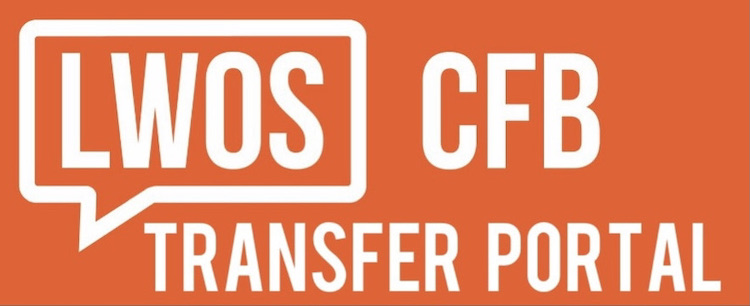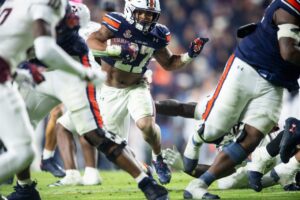National Transfer Portal Update
As we start wrapping up Spring camp coverage for most teams over the coming two weeks, we wanted to provide a mid-Spring national transfer portal update. How do the numbers look for Power Five schools? How do their G5 counterparts fare? We answer that–and more–here.
Numbers Continue to Climb
As we wrote in our prior transfer portal update, 2022 represents the fourth year for the transfer portal. As schools and players become more familiar with its nuances, they continue to avail themselves of the portal as time goes on. We expected more movement through the portal this season for two reasons. First, this is the first full year of NIL compensation rules. Second, the NCAA allowed schools additional scholarships to replace transfer losses.
Because of the first change, we expected some players to look for greener–pun intended–pastures. Because of the second, we expected some schools to “encourage” underperforming players to enter the portal to make room for new talent. We were not sure, however, just how many more players would enter the portal. At the halfway point of Spring, we have a bit more clarity here.
Power Five Numbers
In the first three years, over 2,200 players from Power Five Plus (Power Five schools plus Notre Dame and BYU) schools entered the portal. Each team averaged 11.2 players per year. This year, through April 15, over 960 players entered the 2022 transfer class so far. We certainly expect that number to grow as Spring camps wind up and players approach either graduation or the end of their Spring semesters. That said, as of now, each team averages 14.6 players in the portal.
The average is not skewed high by just a handful of teams either. 31 of the 66 Power Five Plus schools lose 15 or more players to the portal this year. Fourteen of those lose 20 or more. Just 12 schools have lost fewer than ten so far this season. Some schools, of course, are losing more than others.
To date, the following schools represent the “top ten” in terms of the greatest numbers lost to the portal. Indiana ranks first with 31. Washington State follows behind with 26. Four schools tied for third with 23: Arizona, Colorado, USC, and Maryland. Behind them, four schools tie for seventh with 22: Florida State, Auburn, Ole Miss, and West Virginia.
Only two schools face losses of five or fewer so far (since August 1, 2021): Baylor (three) and Iowa (five).
G5 Numbers
As of our mid-Spring National Transfer Portal Update research through April 15 (beginning August 1, 2021), the G5 numbers are lower than Power Five numbers on the whole. This makes sense as G5 players have fewer options to transfer out. In total, the 65 G5 schools are losing 721 total players through portal entrants shown on the 247 Transfer Portal.
This represents an average of 11.1 entrants per school. Like their Power Five Plus counterparts, the G5 average does not skew higher because of a handful of schools. Indeed, 35 (nearly 55%) of the G5 schools have lost ten or more players to the portal so far this year.
As with the Power Five Plus numbers, the Transfer Class of 2022 also represents a substantial increase from prior years. Specifically, from 2019 through 2021, the G5 schools averaged 8.5 losses to the portal per school per year. With many Spring camps still underway, the number represents a 30% increase. We, of course, anticipate that number to grow as Spring camps and second semesters wrap up.
How Green Is the Grass?
We have previously covered this at greater length, at least for the Power Five Plus schools. Truth is that the grass is not always greener. We have not yet broken down the percentages for the Class of 2022, as the class is still growing and a large percentage of kids still have not made decisions on their transfer destinations. As a result, our numbers below focus on where transfer portal entrants ended up between 2019 and 2021.
For Power Five schools, only 25.5% of transfer portal entrants found their way to another Power Five Plus institution. That means that just under three-quarters of all Power Five Plus portal entrants in the portal’s first three years transferred “down” to a school playing at a lower level of competition. This reality is fine for some players. Certainly, some players simply find out that they are not likely starters at the Power Five level. That said, we have a hard time believing that nearly 75% of all portal entrants knew they would end up transferring to a lower level of competition.
Not surprisingly, these numbers for G5 schools are bleak. For G5 transfers, just under 12 percent of them found their way onto Power Five Plus rosters. Another 12 percent found landing spots at other G5 schools. The remaining 76 percent transferred “down” either to unknown destinations, out of football entirely, or to the FCS of Junior College circuits. Again, while this represents reality for some players (and they know it), we have a hard time believing 76 percent of all 1,250 or so transfer portal entrants over the last three years willingly gave up their G5 scholarships to transfer to schools where scholarships are much more limited and exposure is even more limited.
We will provide yet another National Transfer Portal Update in the coming months as post-Spring transfers enter their names into the portal. After August, we will then provide another breakdown of where kids end up once they jump through the portal.






